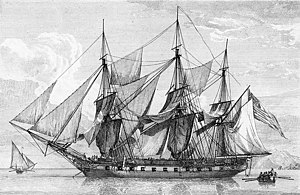
The Quasi-War was an undeclared naval war fought from 1798 to 1800 between the United States and the French First Republic, primarily in the Caribbean and off the East Coast of the United States.
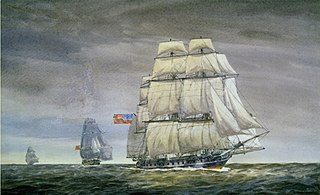
USS Adams was a 28-gun (rated) sailing frigate of the United States Navy. She was laid down in 1797 at New York City by John Jackson and William Sheffield and launched on 8 June 1799. Captain Richard Valentine Morris took command of the ship.

John Shaw was an Irish-born American officer in the United States Navy.
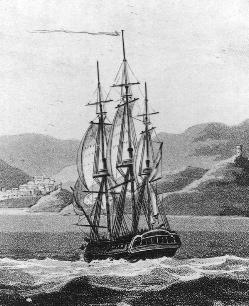
USS Philadelphia, a 1240-ton, 36-gun frigate, was the second vessel of the United States Navy to be named for the city of Philadelphia. Originally named City of Philadelphia, she was built in 1798–1799 for the United States government by residents of that city. Funding for her construction was raised by a drive that collected $100,000 in one week, in June 1798. She was designed by Josiah Fox and built by Samuel Humphreys, Nathaniel Hutton and John Delavue. Her carved work was done by William Rush of Philadelphia. She was laid down about November 14, 1798, launched on November 28, 1799, and commissioned on April 5, 1800, with Captain Stephen Decatur, Sr. in command. She was captured by Barbary pirates in Tripoli with William Bainbridge in command. Stephen Decatur led a raid that burned her down, preventing her use by the pirates.

Stephen Decatur Sr. was an American privateer in the Revolutionary War and later in the Quasi-War was commissioned as a captain in the United States Navy. He was the father of Stephen Decatur Jr.

USS Constellation was a nominally rated 38-gun wooden-hulled, three-masted frigate of the United States Navy.

The first USS Essex of the United States Navy was a 36-gun or 32-gun sailing frigate that participated in the Quasi-War with France, the First Barbary War, and in the War of 1812. The British captured her in 1814 and she then served as HMS Essex until sold at public auction on 6 June 1837.

David Porter was an officer in the United States Navy in the rank of captain and the honorary title of commodore. Porter commanded a number of U.S. naval ships. He saw service in the First Barbary War, the War of 1812 and in the West Indies. On July 2, 1812, Porter hoisted the banner "Free trade and sailors' rights" as captain of USS Essex. The phrase resonated with many Americans. Porter was later court martialed; he resigned and then joined and became commander-in-chief of the Mexican Navy. Porter County, Indiana was named after him.
USS New York was a three-masted, wooden-hulled sailing frigate in the United States Navy that saw service during the Quasi-War with France.
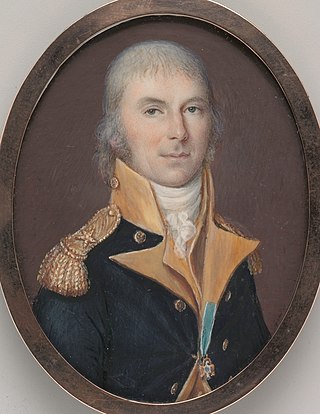
Commodore Alexander Murray was an officer who served in the Continental Navy, the Continental Army, and later the United States Navy, during the American Revolutionary War, the Quasi-War with France and the First Barbary War in North Africa.
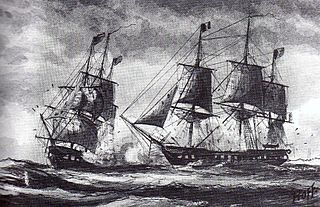
L'Insurgente was a 40-gun Sémillante-class frigate of the French Navy, launched in 1793. During the Quasi War with the United States, the United States Navy frigate USS Constellation, with Captain Thomas Truxtun in command, captured her off the island of Nevis. After her capture she served in the United States Navy as USS Insurgent, patrolling the waters in the West Indies. In September 1800 she was caught up in a severe storm and was presumed lost at sea.
George Little was a United States Navy officer. He served in the Massachusetts State Navy during the Revolutionary War and in the United States Navy during the Quasi-War with France.

USS Pickering was a brig, the 1st brig built for the UCRC Service, in the United States Revenue Cutter Service and then the United States Navy during the Quasi-War with France. She was named for Timothy Pickering, then the Secretary of State.
The first USS George Washington was a frigate in the United States Navy. She was named after United States Founding Father and President George Washington.
The second USS Delaware was a ship which served in the United States Navy during Quasi-War with France.
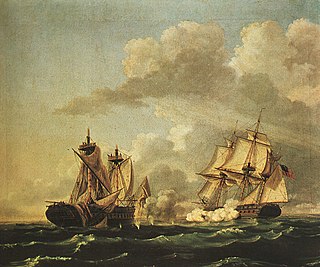
The capture of HMS Macedonian was a naval action fought near Madeira on 25 October 1812 between the heavy frigate USS United States, commanded by Stephen Decatur, and the frigate HMS Macedonian, under the command of John Surman Carden. The American vessel won the long bloody battle, capturing and bringing Macedonian back to the United States. It was the first British warship to ever be brought into an American harbor.
USS Herald was a full-rigged ship of about 270 tons burthen built in 1797 at Newburyport, Massachusetts. The US Navy purchased her on 15 June 1798, and sold her in 1801. She became the French 20-gun privateer corvette Africaine. In 1804 a British privateer seized her on 4 May 1804 off the coast, near Charleston, South Carolina. The seizure gave rise to a case in the U.S. courts that defined the limits of U.S. territorial waters. The U.S. courts ruled that the privateer had seized Africaine outside U.S. jurisdiction. Africaine then became a Liverpool-based slave ship that made two voyages carrying slaves from West Africa to the West Indies. After the abolition of the slave trade in 1807 she became a West Indiaman that two French privateers captured in late 1807 or early 1808.

Berceau was a 22-gun corvette of the French Navy, built to a design by Jacques-Noël Sané, and launched in 1794. The Americans captured her in 1800 but restored her to France the next year. She then served in the Indian Ocean before returning to Spain, where she was broken up in 1804.

USS Constellation vs L'Insurgente, or the action of 9 February 1799, was a single-ship action fought between frigates of the French Navy and the United States Navy during the Quasi-War, an undeclared war that lasted from 1798 to 1800. The battle resulted in USS Constellation's capture of L'Insurgente, after an intense firefight in which both sides exchanged heavy broadsides and musket fire.
